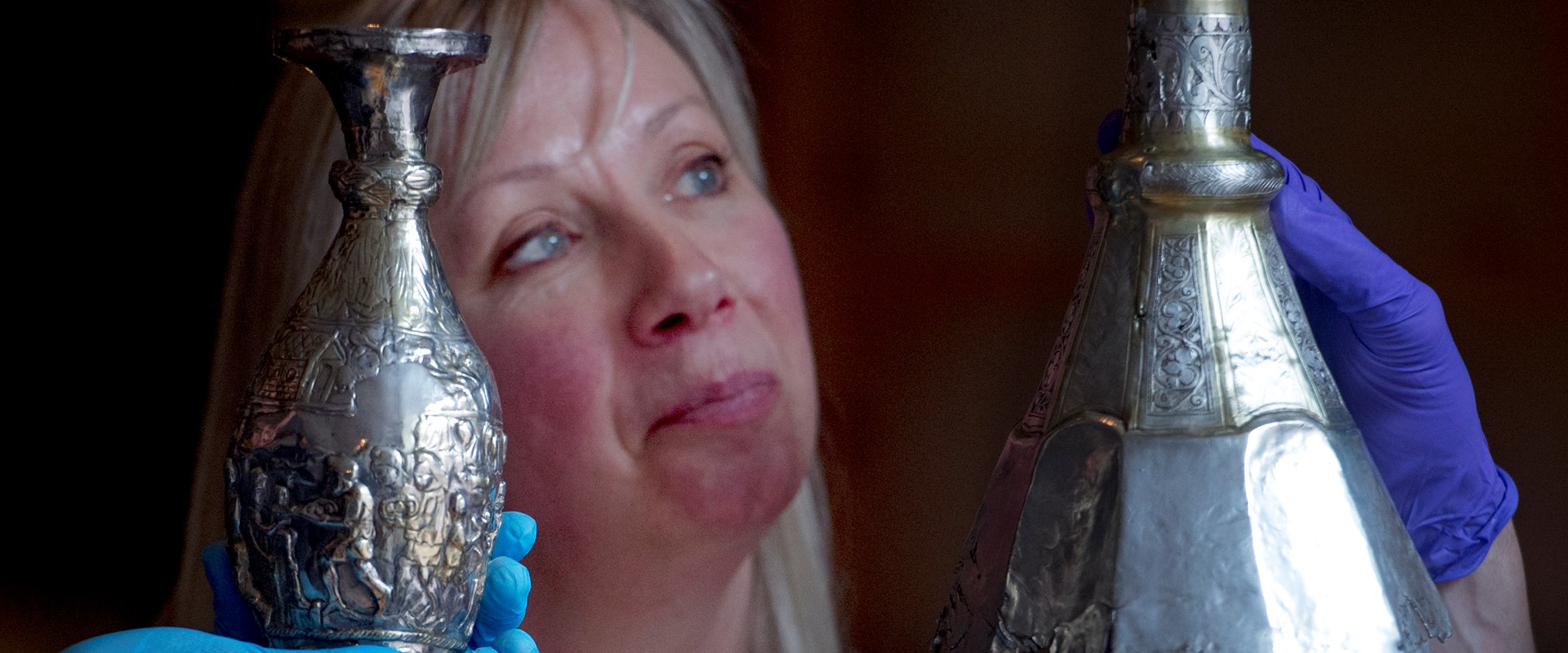A stunning new exhibition at the John Gray Centre, Haddington, will open on Saturday 11 May featuring many of the iconic pieces from the spectacular Traprain Treasure, found on Traprain Law 100 years ago. This is the first time this internationally significant Roman silver can be seen in East Lothian since its discovery in 1919.
The Traprain Treasure is the largest hoard of late Roman ‘hacksilver’ found anywhere in Europe. It consists of fragments from over 250 silver objects, that had been cut into set weights of bullion and sent north from the Roman world, probably as a diplomatic gift. They were found buried in a pit within a hill fort during an archaeological excavation.
The Treasures from the Hoard exhibition takes over the first gallery of the museum, involving a total revamp of the gallery and features real and replica objects. A programme of talks and events are planned to mark the centenary, both in East Lothian and at the National Museum of Scotland.
The exhibition is curated by Dr Claire Pannell of East Lothian Council Museums Service, with assistance from Dr Fraser Hunter of National Museums Scotland. It is supported by loans from National Museums Scotland and private lenders, with financial support from Museums Galleries Scotland.
The hoard was buried more than 1,500 years ago, around AD 450. When first found, it was thought that barbarians had stolen the ‘loot’ from retreating Romans. However, following extensive research by Dr Hunter into other hacksilver hoards across Europe, it was more likely cut up within the Roman world at times of economic crisis, when precious metal was valued as bullion rather than as fancy vessels. It was then sent north as diplomatic gifts (or payment for military assistance) to the powerful leaders on Traprain Law, as a way of buying their support and keeping the Roman frontier secure. This silver was intended for the melting pot – Roman silver bullion was melted down and made into the first ever items of Scottish silver jewellery, with examples of this from the Traprain Law settlement itself.
East Lothian Provost, John McMillan, said:
“We are absolutely delighted to have some of the pieces from this collection available for the exhibition during the centenary year of the amazing discovery. I am sure both local residents and visitors alike will be fascinated by the story of the discovery and also the history of the hoard.”
Dr Hunter, whose research into the hoard will be published in a new book, The late Roman silver treasure from Traprain Law, due out this summer, said:
“The Traprain Treasure is the most significant silver find from beyond the Roman frontier right across Europe. A century after its discovery, it’s exciting that it can still reveal new insights. It’s a key part of this fascinating period in our history, and I’m sure it’ll dazzle those who see it. We are delighted to be supporting its display in East Lothian, which is a fitting way to mark the centenary of its discovery”
Treasures from the Hoard exhibition runs from 11 May until 27 October. Check the JGC website for opening times www.johngraycentre.org
For further information and images contact Bruce Blacklaw, Press Office, National Museums Scotland, 0131 247 4165, b.blacklaw@nms.ac.uk
Notes to editors
-
National Museums Scotland is one of the leading museum groups in the UK and Europe and it looks after collections of national and international importance. The organisation provides loans, partnerships, research and training in Scotland and internationally. Our individual museums are the National Museum of Scotland, the National Museum of Flight, the National Museum of Rural Life and the National War Museum. The National Museums Collection Centre in Edinburgh houses conservation and research facilities as well as collections not currently on display.
-
Twitter: @NtlMuseumsScot
-
Facebook: facebook.com/NationalMuseumsScotland
-
Instagram: @NationalMuseumsScotland
-
The National Museum of Scotland is the most popular attraction in the country outside of London (source: Association of Leading Visitor Attractions). The National Museum of Scotland was awarded ‘Gold’ Level Green Tourism Visitor Attraction status in 2016.
-
Bheireadh Oifis nam Meadhanan eadar-theangachadh Gàidhlig den bhrath-naidheachd seachad do bhuidhinn mheadhanan bharantaichte. Cuiribh fios do dh'Oifis nam Meadhanan airson bruidhinn air cinn-latha freagarrach.

